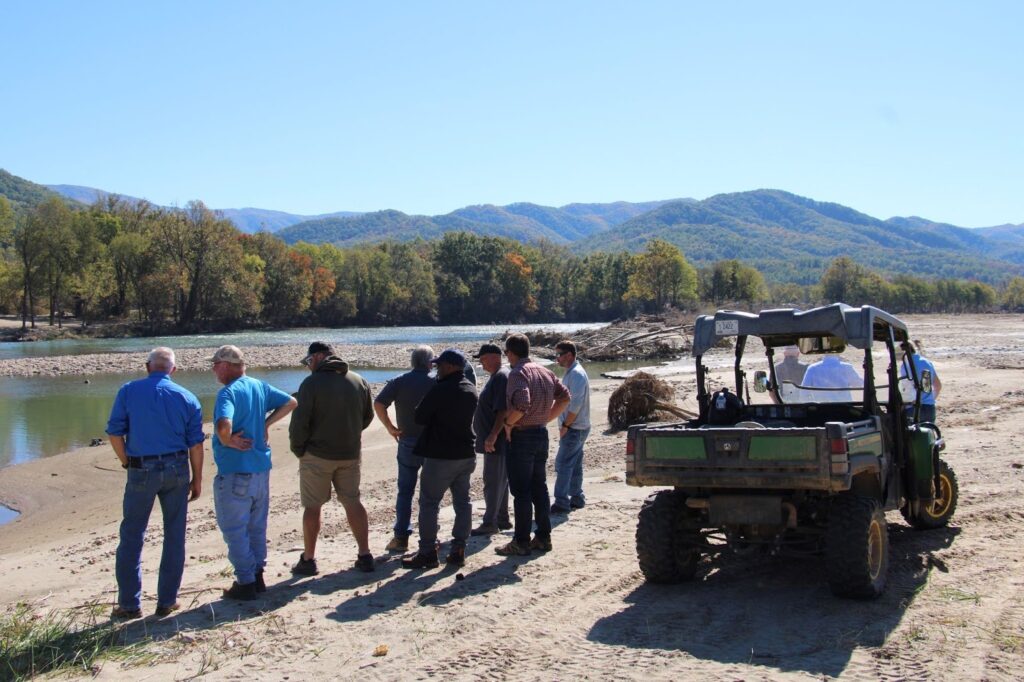
Thousands of acres of East Tennessee farmland have been devastated by flood waters that rushed through the region as the remnants of Hurricane Helene moved through. But state officials say they “don’t have a lot of money” to help.
In some cases, the soil was entirely washed away, leaving nothing but bedrock.
John Hilemon II is the third generation of his family to farm a tract of land on the banks of the Nolichucky River near the town of Erwin in Unicoi County. He keeps cattle and sells hay from his pasture to a nearby horse ranch.
When Helene caused waters to surge by 35 feet along the river, he and his family lost 650 acres of land, 1,000 bales of hay, millions of dollars worth of equipment, and their livelihood in an instant. The land has been reduced to nothing but sand and silt, which can no longer produce grass for grazing or hay for rolling. His barns have been shredded to pieces, and some of his equipment was picked up and carried miles downstream by the flood.
“In four hours, I literally lost everything,” Hilemon said. “I can sit here and tell you about the hay and the hay equipment … but how can I ever put you a price on the land? Because how can I ever rebuild that?”
The Hilemon family farm is just one of hundreds along the Nolichucky River destroyed by raging flood waters brought on by Helene. One USDA official estimates billions of dollars of damages have been dealt to the agriculture industry in Tennessee.
University of Tennessee’s Unicoi County Extension Office Director Chris Mackey says it may be years before farms in the region can start producing again.
“It’s going to take quite a bit of time to try and revitalize what land was in use, if it’s even going to be able to be put back into production,” Mackey said. “In a lot of places, there’s still feet of sand and silt and mud that’s on top of their property.”
Mackey stressed the importance of the agriculture industry, and the essential role that farmers fill in “feeding the world.” It’s one of the largest industries in Tennessee, generating nearly $60 billion in output and accounting for 41% of its total land use.
But, despite its importance, there aren’t a lot of resources available to help farms with the immediate recovery process.
On one sunny Monday in October, several dozen farmers gathered in the yard of a local pastor in Washington County to meet with representatives from the state and U.S. departments of agriculture to figure out what might be available to them.
While there, Tennessee Department of Agriculture Deputy Commissioner Jeff Aiken told farmers that the agency is trying to get grant funding for some relief programs.
“We don’t have a lot of money, obviously, that we can commit to the thing right now,” Aiken said.
He did note that the agency has extended the signup deadline for its cost share program, known as the Tennessee Agricultural Enhancement Program, which caps out at a few thousand dollars worth of reimbursement. Many farmers are out millions.
John Litz is the executive director of the USDA’s Farm Service Agency office in Tennessee. He told farmers about several programs that the agency is offering, but they’re mostly limited to long-term reimbursement or low-interest loans for specific uses.
“My primary concern is the farmer that has no money and no way to pay for all this,” said Pam Vermillion, a local farmer. “Now we’re kind of at the (point) where we’re kind of on our own, and we have to figure this out.”
Litz, along with a representative from the Farm Service Agency’s Washington, D.C. office, took feedback from the farmers, who were all primarily concerned with the immediate need for financial help.
“Is there any kind of loans?” one farmer asked. “I need to go out here and rent a V6 to start pushing dirt and sand back in these holes, and I’m kindly broke. What do I do?”
“Is there not a way we can automatically get our money back, or get money in the bank to cover that?” asked another.
“We’ll have to talk to our higher-ups,” Litz replied. “We’re not finished with this yet. We’re trying our best to try and figure out how we can better serve farmers and what financial obligations it takes to do that … One of the big things is it takes money to do this. And that money has to come from Congress, and Congress has to appropriate it.”
In the meantime, many farmers are having to front the costs themselves. Back at the Hilemon family farm, John Hilemon II said he’s had to back out of his contracts with buyers and pick up night shifts at his second job, so he can work on the farm during the day.
“I figured it up the other day,” Hilemon said. “If I didn’t keep a bit of money for myself, I’d work the next 40 years and still not be able to pay off what we’re out right now.”
While he’s grateful for the programs that are available, he said he’ll still have to take out personal loans to even start the recovery process.
“This is not only affecting me this year. This is going to affect me for years to come.”

